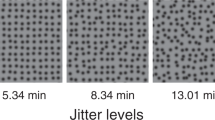Abstract
We report a six-stimulus basis for stochastic texture perception. Fragmentation of the scene by a chaotic process causes the spatial scene statistics to conform to a Weibull-distribution. The parameters of the Weibull distribution characterize the spatial structure of uniform stochastic textures of many different origins completely. In this paper, we report the perceptual significance of the Weibull parameters. We demonstrate the parameters to be sensitive to orthogonal variations in the imaging conditions, specifically to the illumination conditions, camera magnification and resolving power, and the texture orientation. Apparently, the Weibull parameters form a six-stimulus basis for stochastic texture description. The results indicate that texture perception can be approached like the experimental science of colorimetry.
Similar content being viewed by others
References
Bell, A.J. and Sejnowski, T.J. 1997. The independent components of natural scenes are edge filters. Vision Res., 37:3327–3338.
Brown, W.K. 1989. A theory of sequential fragmentation and its astronomical applications. J. Astrophys. Astr, 10:89–112.
Brown, W.K. and Wohletz, K.H. 1995. Derivation of the weibull distribution based on physical principles and its connection to the Rosin-Rammler and lognormal distributions. J. Appl. Phys., 78:2758–2763.
Cula, O.G. and Dana, K.J. 2001. Compact representation of bidirec-tional texture functions. In Proc. IEEE Conf Comput. Vision Pat. Rec., vol. 1, IEEE Computer Society, pp. 1041–1047.
Dana, K.J. and Nayar, S.K. 1999. Correlation model for 3D texture. In Proc. 7th Int. Conf Comput. Vision. IEEE Computer Society, pp. 1061–1066.
Dana, K.J., van Ginneken, B., Nayar, S.K., and Koenderink, J.J. 1999. Reflectance and texture of real world surfaces. ACM Trans Graphics, 18:1–34.
Filliben, J.J. et al. 2002. NIST/SEMTECH Engineering Statis-tics Handbook. Gaithersburg: www.itl.nist.gov/div898handbook, NIST.
Geusebroek, J.M. and Smeulders, A.W.M. 2002. A physical ex-planation for natural image statistics. In Proceedings of the 2nd International Workshop on Texture Analysis and Synthe-sis (Texture 2002). M. Chantler (Ed.), Heriot-Watt University, pp. 47–52.
Geusebroek, J.M. and Smeulders, A.W.M. 2003. Fragmentation in the vision of scenes. In Proc. 9th Int. Conf Comput. Vision. IEEE Computer Society (in press).
Geusebroek, J.M., van den Boomgaard, R., Smeulders, A.W.M., and Geerts, H. 2001. Color invariance. IEEE Trans. Pattern Anal. Ma-chine Intell., 23(12):1338–1350.
Gnedenko, B.V. and Kolmogorov, A.N. 1968. Limit Distributions for Sums of Independent Random Variables. Addison-Wesley: Boston.
Julesz, B. 1981. Textons, the elements of texture perception, and their interactions. Nature, 290:91–97.
Koenderink, J.J. 1984. The structure of images. Biol. Cybern., 50:363–370.
Leung, T. and Malik, J. 2001. Representing and recognizing the vi-sual appearance of materials using three-dimensional textons. Int. J. Comput. Vision, 43:29–44.
Liu, Y. and Tsin, Y. 2002. The promise and the perils of near-regular texture. In Proceedings of the 2ndnternational Workshop on Tex-ture Analysis and Synthesis (Texture 2002). M. Chantler (Ed.), Heriot-Watt University, pp. 77–81.
Mallat, S.G. 1989. A theory for multiresolution signal decomposition: The wavelet representation. IEEE Trans. Pattern Anal. Machine Intell., 11:674–693.
Mandelbrot, B.B 1983. The Fractal Geometry of Nature. W.H. Freeman and Co: New York, NY.
Pentland, AP. 1984. Fractal-based description of natural scenes.IEEE Trans. Pattern Anal. Machine Intell., 6:661–674.
Pentland, AP. 1990. Linear shape from shading. Int. J. Comput. Vision, 4:153–163.
Pont, S.C. and Koenderink, J.J. 2002. Bidirectional texture contrast function. In Proc. 7th Europ. Conf on Comput. Vision. vol. 4, LNCS 2353, Springer-Verlag, pp. 808–822.
Simoncelli, E.P. 1999. Modeling the joint statistics of images in the wavelet domain. In Proc. SPIE. vol. 3813, SPIE, pp. 188–195.
Suen, P. and Healey, G. 2000. The analysis and recognition of real-world textures in three dimensions. IEEE Trans. Pattern Anal. Machine Intell., 22(5):491–503.
Tamura, H., Mori, S., and Yamawaki, T. 1978. Textural features corresponding to visual perception. IEEE Trans. Syst. Man Cybern., 8:460–473.
Zhu, S.C., Liu, X., and Wu, Y.N. 2000. Exploring texture ensembles by efficient Markov Chain Monte Carlo-Toward a trichromacy theory of texture. IEEE Trans. Pattern Anal. Machine Intell., 22:554–569.
Author information
Authors and Affiliations
Rights and permissions
About this article
Cite this article
Geusebroek, JM., Smeulders, A.W. A Six-Stimulus Theory for Stochastic Texture. Int J Comput Vision 62, 7–16 (2005). https://doi.org/10.1023/B:VISI.0000046586.95219.e7
Issue Date:
DOI: https://doi.org/10.1023/B:VISI.0000046586.95219.e7




